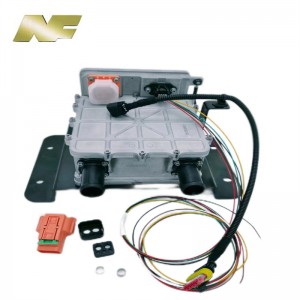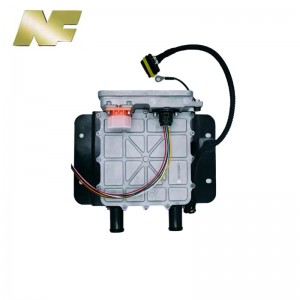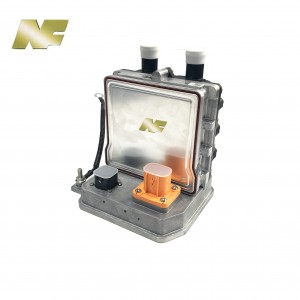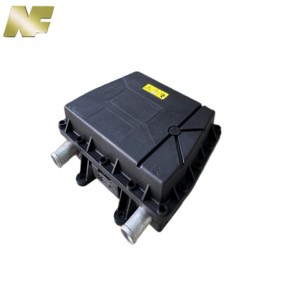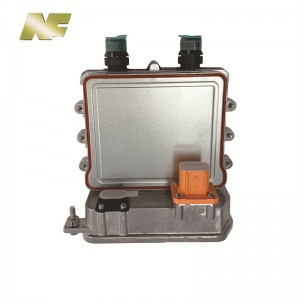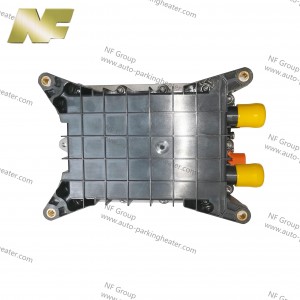NF 9.5KW 600V High Voltage Coolant Heater 24V Electric PTC Heater
Description
In recent years, the automotive industry has witnessed a major shift towards electric vehicles (EVs). As the world embraces sustainable transportation, manufacturers continue to innovate to improve the efficiency, performance and safety of electric vehicles. Two important components that have enabled this advancement are high-voltage PTC heaters and electric vehicle coolant heaters. By combining these cutting-edge technologies, these EVs ensure a reliable and comfortable driving experience while maximizing battery efficiency. In this blog, we will explore the features, benefits and future prospects of high voltage PTC heaters and electric vehicle coolant heaters, and shed light on their role in shaping the future of electric vehicles.
Function of high voltage PTC heater :
The advent of electric vehicles brings new challenges in maintaining optimum cabin comfort in cold weather conditions. To solve this problem, high-voltage positive temperature coefficient (PTC) heaters have emerged as an integral component. These heaters are designed to heat the cabin without the need for conventional heating systems that consume too much electricity.
High voltage PTC heaters operate using the PTC effect, which causes their electrical resistance to increase dramatically with temperature. This unique characteristic allows PTC heaters to self-regulate their power output. By employing a high-voltage system of 400V or higher, efficient power distribution can be achieved among various vehicle components including PTC heaters. This ensures fast, even and targeted heating of the compartment while minimizing power consumption.
Advantages of high-voltage PTC heaters :
There are many advantages to using high voltage PTC heaters in electric vehicles, both for the driver and for the environment. Firstly, these heaters significantly reduce energy consumption compared to conventional heating systems. By efficiently directing heat to desired areas within the vehicle, high-voltage PTC heaters minimize unnecessary energy waste, allowing electric vehicles to extend their driving range.
In addition, these heaters operate quietly and provide instant warmth, providing occupants with a comfortable experience from the moment they enter the vehicle. High voltage PTC heaters also help extend the life of the battery pack by reducing reliance on battery energy for heating.
Electric vehicle coolant heater and its role in battery optimization:
In addition to high-voltage PTC heaters, EV coolant heaters also play a vital role in maximizing EV performance. These heaters ensure optimal battery condition by keeping the coolant temperature within the desired range. Efficient battery temperature management is critical to battery performance, life, and charging efficiency.
Electric vehicle coolant heaters use electricity from the vehicle's high-voltage system to heat the coolant flowing through the battery pack. This allows the battery to quickly reach its optimum operating temperature, ensuring optimum charge acceptance and enhancing energy conversion during regenerative braking or acceleration. By preventing battery inefficiencies associated with low temperatures, electric vehicle coolant heaters improve the overall energy efficiency of electric vehicles.
Future Prospect and Innovation:
As the electric vehicle industry continues to grow, the prospects for further development of high-voltage PTC heaters and electric vehicle coolant heaters are exciting. The integration of these two technologies opens up opportunities for smart climate control systems in electric vehicles.
One potential development is the use of smart sensors linked to advanced thermal management systems. These sensors dynamically assess in-vehicle temperature, humidity and occupant preferences, allowing the PTC heater and coolant heater to adjust their functionality accordingly, optimizing the driving experience.
Additionally, advances in materials and manufacturing processes are helping to increase the efficiency and reduce cost of these heaters. Improved thermal insulation and compact design will allow automakers to maximize cabin space while ensuring superior heating performance.
Conclusion:
High-voltage PTC heaters and electric vehicle coolant heaters have revolutionized the way electric vehicles handle cold weather conditions. These advanced components combine energy efficiency, battery optimization and passenger comfort to contribute to a sustainable future of transportation. As technological capabilities improve, electric vehicles will only become more attractive and accessible to all.
Technical Parameter
| Size | 225.6×179.5×117mm |
| Rated power | ≥9KW@20LPM@20℃ |
| Rated voltage | 600VDC |
| High voltage range | 380-750VDC |
| Low voltage | 24V,16~32V |
| Storage temperature | -40~105 ℃ |
| Operating temperature | -40~105 ℃ |
| Coolant temperature | -40~90 ℃ |
| Communication method | CAN |
| Control method | Gear |
| Flow range | 20LPM |
| Air tightness | Water chamber side ≤2@0.35MPaControl box≤2@0.05MPa |
| Degree of protection | IP67 |
| Net weight | 4.58 KG |
Application

Our Company


Hebei Nanfeng Automobile Equipment (Group) Co., Ltd is a group company with 5 factories, that specially produce parking heaters, heater parts, air conditioner and electric vehicle parts for more than 30 years. We are the leading auto parts manufacturers in China.
Our factory's production units are equipped with high tech machineries, strict quality,control testing devices and a team of professional technicians and engineers endorsing the quality and authenticity of our products.
In 2006, our company has passed ISO/TS16949:2002 quality management system certification. We also bagged the CE certificate and Emark certificate making us among the only few companies in the world acquiring such high level certifications.
Currently being the largest stakeholders in China, we hold a domestic market share of 40% and then we export them around the globe particularly in Asia, Europe and Americas.
Meeting the standards and demands of our customers have always been our top priority. It always encourages our experts to continuously brain storm, innovate, design and manufacture new products, impeccably suitable for the Chinese market and our customers from every nook of the world.
FAQ
Q: What is a High Voltage Coolant Heater?
A: A high-voltage coolant heater is a device used to preheat engine coolant in hybrid and electric vehicles. It ensures that the vehicle's engine and battery systems reach optimal temperatures before starting, thereby improving the vehicle's overall performance and efficiency.
Q: HOW DOES THE HIGH VOLTAGE COOLANT HEATER WORK?
A: The high-voltage coolant heater uses electricity from the vehicle's battery system or an external power source to heat the engine coolant. The heated coolant then circulates throughout the engine and other components, helping to maintain proper operating temperatures even in cold weather conditions.
Q: Why is it important to use high-voltage coolant heaters in hybrid and electric vehicles?
A: High voltage coolant heaters play a vital role in hybrid and electric vehicles as they help improve the overall efficiency of the vehicle. By preheating the engine coolant, these heaters reduce the stress on the engine and battery system during start-up, providing better fuel efficiency and extending component life.
Q: Are high voltage coolant heaters only needed in cold climates?
A: While high voltage coolant heaters are especially beneficial in cold climates, there are advantages in mild or hot climates as well. By preheating the engine coolant, these heaters minimize wear and tear on the engine, improving performance and extending service life.
Q: Can the high voltage coolant heater be retrofitted to an existing hybrid or electric vehicle?
A: In most cases, high voltage coolant heaters can be retrofitted to existing hybrid and electric vehicles. However, it is recommended to consult a professional technician or the vehicle manufacturer to determine compatibility and necessary modifications.
Q: Can the high voltage coolant heater be used with any type of coolant?
A: High voltage coolant heaters are designed for use with the recommended coolant specified by the vehicle manufacturer. Using the correct coolant is very important to ensure optimal performance and prevent any damage to your system.
Q: What are the benefits of using a high voltage coolant heater?
A: Some of the benefits of using a high voltage coolant heater include improved fuel efficiency, reduced engine wear, enhanced battery performance, reduced emissions, and faster cab heating in cold weather.
Q: Can the high voltage coolant heater be programmed or controlled remotely?
A: Many modern high voltage coolant heaters offer programmable settings and remote control options. These features allow users to schedule heating cycles and control the heater through a mobile app or key fob, providing convenience and comfort.
Q: How long does it take for the high voltage coolant heater to warm up the engine?
A: The warm-up time for the high voltage coolant heater may vary depending on factors such as ambient temperature, vehicle model and engine size. Typically, it takes anywhere from 30 minutes to several hours to heat the engine coolant to the desired temperature.
Q: Are high voltage coolant heaters energy efficient?
A: High voltage coolant heaters are usually designed to be energy efficient. They consume relatively low power while providing significant benefits in improving vehicle efficiency and performance. However, specific power consumption may vary by model and usage pattern.


